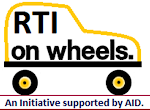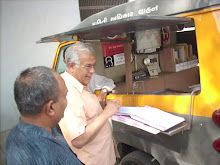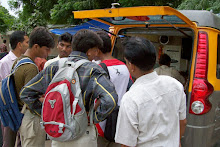Binay Singh, TNN, Sep 10, 2010 ; Varanasi ;
VARANASI: While the country celebrated the Nation Nutrition Week from September 1 to 7 with an aim to create nutrition awareness through training, education, seminars, competitions and road shows, the Varanasi district distanced itself from such programmes. Reason being the health department had no idea about the nutrition week.
When contacted to get some feedback on the nutritional programmes organised in the district during the week, the chief medical officer expressed his ignorance about the nutrition week. "We have no idea and we did not get any order from the government in this regard," CMO RS Verma told TOI on Friday.
It was really strange that a CMO-level officer was ignorant about such an important programme, particularly when the Food and Nutrition Board (FNB), Ministry of Women and Child Development, celebrates the week annually in the country. For mass awareness campaigns, the FNB undertakes various activities including nationwide celebration of events like World Breast Feeding Week (August 1-7), National Nutrition Week (September 1-7), World Food Day (October 16), Global Iodine Deficiency Disorder ( IDD) Prevention Day (October 21), Universal Children's Day (November 14), International Women's Day (March 8). These events are organised with active cooperation from respective state governments, educational institutions and NGOs. Dissemination of nutrition information to the masses is also undertaken by organising exhibitions on nutrition at various fairs.
Nutrition is the focal point of health and wellbeing and it is directly linked to human resource development, productivity and ultimately to the national growth. The FNBs report clearly suggests that malnutrition is a complex phenomenon, which is both the cause and effect of poverty and ill health and follows a cyclical, inter-generational pattern. It is inextricably linked with illiteracy, especially female illiteracy, lack of safe drinking water and proper sanitation, ignorance, lack of awareness and ill health. It creates its own cycle within the large cycle of poverty. Malnutrition in India continues to be at a high level with 42.5 per cent children below the age of six being underweight and almost 70 per cent being anaemic. About 22 per cent children are born with low birth weight.
According to FNB report, lack of adequate information on nutritional needs has been identified as a major factor for the prevailing nutritional situation in the country. Child malnutrition is the result of both poor economic conditions and poor nutritional awareness. Nutrition education and extension has been recognised as one of the long-term sustainable interventions essential to tackle the problem of malnutrition and to generate awareness and to promote the nutrition status of the country.
In such a situation when the district health department is ignorant about the awareness programmes, what will be the fate of nutritional programmes? The Integrated Child Development Services Scheme (ICDS), the largest of all food supplementation programmes initiated in 1975, is running in the district, but hundreds of children are still identified as malnourished. The scheme a ims at improving the health and nutritional status of children of 0-6 years by providing supplementary food through the nation-wide chain of anganwadi centres (AWCs).
According to the district programme office, there are 2,529 AWCs and 627 mini centres have been sanction by the Central government for those peripheral areas where situation is alarming and which are not covered under ICDS programme.
In an information provided in June under the RTI Act by the child development project officer of Kashi Vidyapeeth block of Varanasi, as many as 92 children were found malnourished (PEM grade III and IV) in this block alone. This number will definitely go higher if proper survey is conducted in all eight blocks and two city areas.
Not only children but the primary need of the fairer sex, particularly adolescent girls, for proper nourishment has also been overlooked. According to a study conducted by the medicos of the Banaras Hindu University (BHU), the nutritional status of adolescent girls was not satisfactory. The study was conducted by the department of community medicine (Preventive and Social Medicine), Institute of Medical Science (IMS), BHU, to assess the nutritional status of rural adolescent girls in Chiraigaon block. It was found that about 19.63 per cent adolescent girls suffered from chronic energy deficiency (CED) grade I; corresponding value for grade II and grade III was 17.78 per cent and 31.11 per cent respectively.














































































